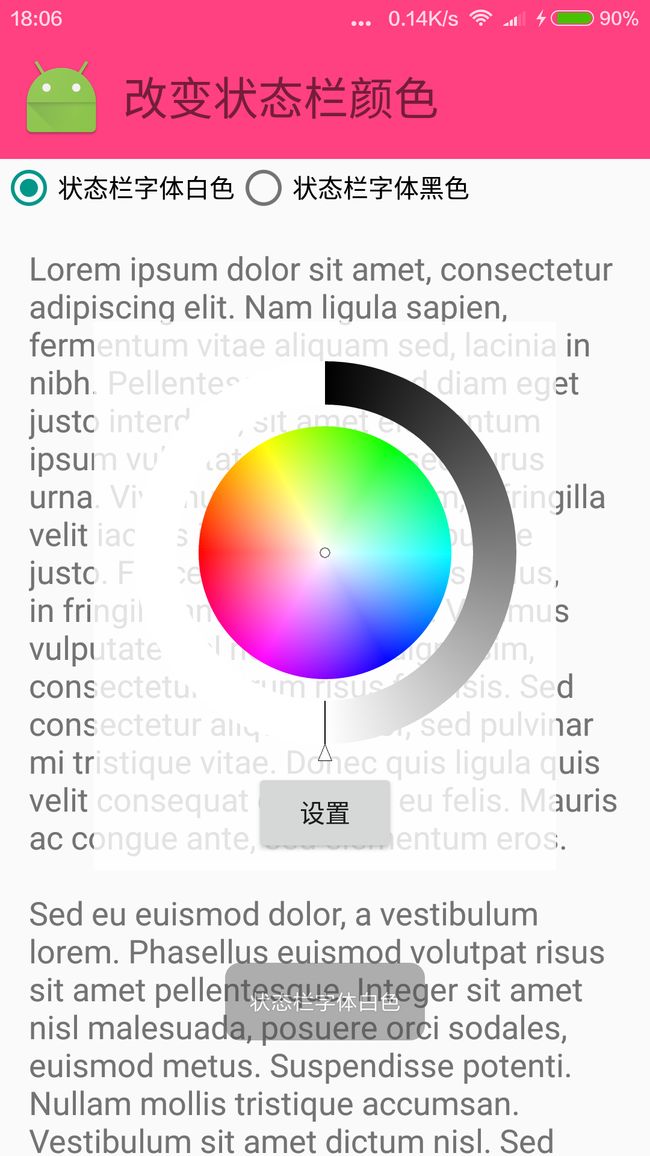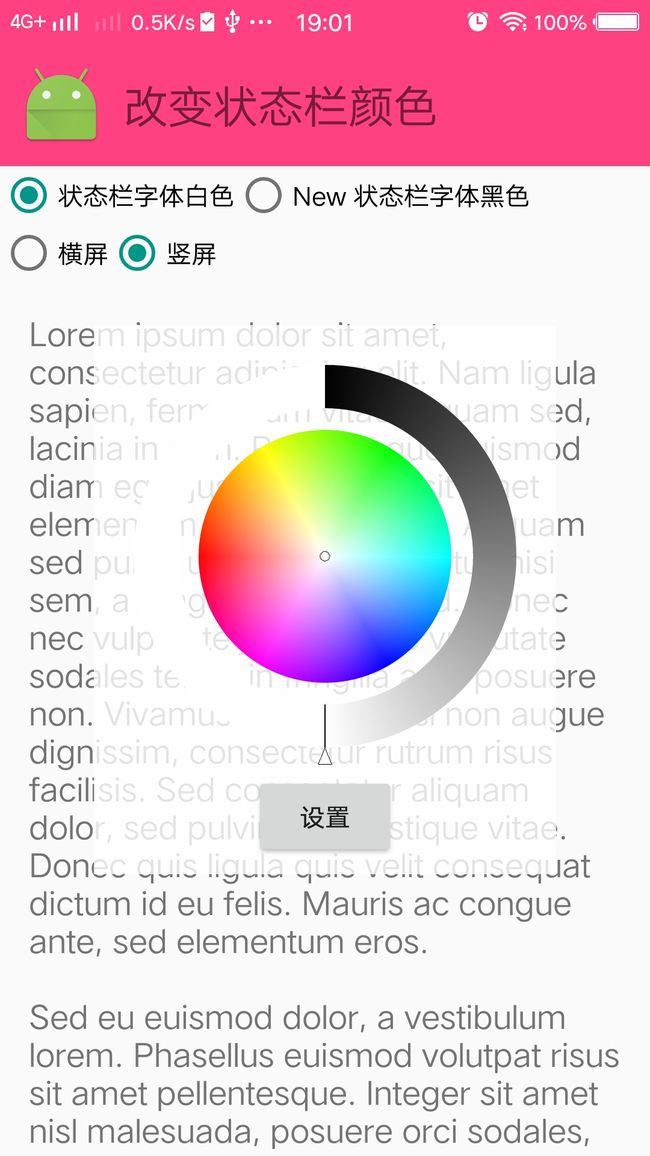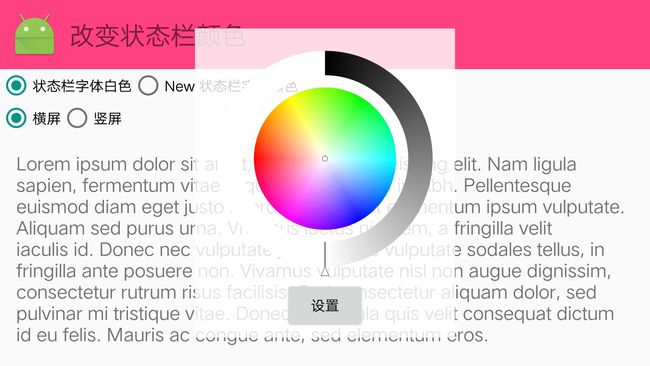沉浸式状态栏全屏使用时的问题
由于公司需要,把之前写过的ChangeStatusColor-Android项目有进行了改进,之前的项目已经支持了MIUI6+、Flyme4+和android6.0以上的字体颜色改变和android4.4以上的沉浸式状态栏。
请看下面两张图,这里的截图机型是小米4 MIUI7 Android6.0.1:
| 状态栏颜色为白色 | 状态栏颜色为黑 |
|---|---|
 |
 |
之前如果横屏设置的不是全屏模式的话,横竖屏切换切换没有问题,但是横屏模式设置全屏模式后,android4.4到android5。0之间会发现标题栏会被状态栏遮挡住,就像图中的第一张图,真正我们想要的是第四张图,如下图所示:

原因在于之前在setStatusBarColor()方法中做了判断
/**
* 修改状态栏颜色,支持4.4以上版本
*
* @param activity
* @param colorId 直接使用资源ID,即R.color.xxx
* @param isFollow 是否保持沉浸式状态
*/
public static void setStatusBarColor(Activity activity, int colorId, boolean isFollow) {
if (Build.VERSION.SDK_INT >= Build.VERSION_CODES.LOLLIPOP) {
Window window = activity.getWindow();
// window.addFlags(WindowManager.LayoutParams.FLAG_DRAWS_SYSTEM_BAR_BACKGROUNDS);
if (!isFollow) {
window.setStatusBarColor(colorId);
}
} else if (Build.VERSION.SDK_INT >= Build.VERSION_CODES.KITKAT) {
//使用SystemBarTint库使4.4版本状态栏变色,需要先将状态栏设置为透明
transparencyBar(activity);
ViewGroup contentFrameLayout = (ViewGroup) activity.findViewById(Window.ID_ANDROID_CONTENT);
View parentView = contentFrameLayout.getChildAt(0);
if (parentView != null && Build.VERSION.SDK_INT >= Build.VERSION_CODES.ICE_CREAM_SANDWICH) {
parentView.setFitsSystemWindows(true);
}
tintManager = new SystemBarTintManager(activity);
tintManager.setStatusBarTintEnabled(true);
tintManager.setStatusBarTintColor(colorId);
/*// set a custom tint color for all system bars
tintManager.setTintColor(Color.parseColor("#99000FF"));
// set a custom navigation bar resource
tintManager.setNavigationBarTintResource(R.drawable.my_tint);
// set a custom status bar drawable
tintManager.setStatusBarTintDrawable(MyDrawable);*/
}
}就是这句代码导致了上面的问题出现了
if (parentView != null && Build.VERSION.SDK_INT >= Build.VERSION_CODES.ICE_CREAM_SANDWICH) {
parentView.setFitsSystemWindows(true);
}解决方案:
/**
* 设置WindowManager.LayoutParams.FLAG_FULLSCREEN时,由于使用了fitSystemWindows()方法,导致的问题
* 支持4.4以上版本,在5.0以上可以不需要调用该方法了
* @param activity
* @param flag_fullscreen true:添加全屏 false:清除全屏
*/
public static void setFitsSystemWindows(Activity activity, boolean flag_fullscreen) {
ViewGroup contentFrameLayout = (ViewGroup) activity.findViewById(Window.ID_ANDROID_CONTENT);
View parentView = contentFrameLayout.getChildAt(0);
if(flag_fullscreen){
activity.getWindow().addFlags(WindowManager.LayoutParams.FLAG_FULLSCREEN);//全屏
}else {
activity.getWindow().clearFlags(WindowManager.LayoutParams.FLAG_FULLSCREEN);//清除全屏
}
if (parentView != null && Build.VERSION.SDK_INT >= Build.VERSION_CODES.ICE_CREAM_SANDWICH && Build.VERSION.SDK_INT <= Build.VERSION_CODES.LOLLIPOP) {
if (tintManager != null) {
if (flag_fullscreen) {
tintManager.setStatusBarTintEnabled(false);
} else {
tintManager.setStatusBarTintEnabled(true);
}
}
}
}首先该方法仅对android4.4~android5.0之间有效,如果横竖屏切换,只要调用该方法就可以解决上图所说的问题了。
使用方式:
在onCreate()方法中调用
StatusBarUtil.setStatusBarColor(MainActivity.this, getResources().getColor(R.color.colorAccent), false);如果在onCreate()方法中不起作用,可以把它放在onStart()方法中
@Override
protected void onStart() {
super.onStart();
StatusBarUtil.setStatusBarColor(mActivity, getResources().getColor(R.color.common_top_bar), false);
}追其原因是StatusBarUtil#setStatusBarColor()->SystemBarTintManager#SystemBarConfig,mStatusBarHeight = getInternalDimensionSize(res, STATUS_BAR_HEIGHT_RES_NAME);这句代码获取状态栏高度为0在onCreate()方法中。
如果要横竖屏切换,首先要在AndroidManifest.xml中Activity设置android:configChanges=”keyboardHidden|orientation|screenSize”
<activity
android:name=".MainActivity"
android:theme="@style/NoActionBar"
android:configChanges="keyboardHidden|orientation|screenSize">
activity>然后重写onConfigurationChanged()方法
@Override
public void onConfigurationChanged(Configuration newConfig) {
super.onConfigurationChanged(newConfig);
if (this.getResources().getConfiguration().orientation == Configuration.ORIENTATION_LANDSCAPE) {// 横屏
// Log.e(TAG, "onConfigurationChanged: " + "横屏");
} else if (this.getResources().getConfiguration().orientation == Configuration.ORIENTATION_PORTRAIT) {
// Log.e(TAG, "onConfigurationChanged: " + "竖屏");
}
}手动切换横竖屏,项目中的代码案例,在切换的时候调用StatusBarUtil.setFitsSystemWindows()方法
mRadioGroupConfiguration.setOnCheckedChangeListener(new RadioGroup.OnCheckedChangeListener() {
@Override
public void onCheckedChanged(RadioGroup group, @IdRes int checkedId) {
if (checkedId == R.id.rb_landscape){//横屏
setRequestedOrientation(ActivityInfo.SCREEN_ORIENTATION_LANDSCAPE);
// getWindow().addFlags(WindowManager.LayoutParams.FLAG_FULLSCREEN);//全屏
StatusBarUtil.setFitsSystemWindows(MainActivity.this, true);
}else if(checkedId == R.id.rb_portrait){//竖屏
setRequestedOrientation(ActivityInfo.SCREEN_ORIENTATION_PORTRAIT);// 竖屏
// getWindow().clearFlags(WindowManager.LayoutParams.FLAG_FULLSCREEN);//清除全屏
StatusBarUtil.setFitsSystemWindows(MainActivity.this, false);
}
}
});最后送上解决后的效果图:
| 竖屏状态 | 横屏状态 |
|---|---|
 |
 |